Intel's Haswell Architecture Analyzed: Building a New PC and a New Intel
by Anand Lal Shimpi on October 5, 2012 2:45 AM ESTPlatform Retargeting
Since the introduction of Conroe/Merom back in 2006 Intel has been prioritizing notebooks for the majority of its processor designs. The TDP target for these architectures was set around 35 - 45W. Higher and lower TDPs were hit by binning and scaling voltage. The rule of thumb is a single architecture can efficiently cover an order of magnitude of TDPs. In the case of these architectures we saw them scale all the way up to 130W and all the way down to 17W.

In the middle of 2011 Intel announced its Ultrabook initiative, and at the same time mentioned that Haswell would shift Intel's notebook design target from 35 - 45W down to 10 - 20W.
At the time I didn't think too much about the new design target, but everything makes a lot more sense now. This isn't a "simple" architectural shift, it's a complete rethinking of how Intel approaches platform design. More importantly than Haswell's 10 - 20W design point, is the new expanded SoC design target. I'll get to the second part shortly.
Platform Power
There will be four client focused categories of Haswell, and I can only talk about three of them now. There are the standard voltage desktop parts, the mobile parts and the ultra-mobile parts: Haswell, Haswell M and Haswell U. There's a fourth category of Haswell that may happen but a lot is still up in the air on that line.
Of the three that Intel is talking about now, the first two (Haswell/Haswell M) don't do anything revolutionary on the platform power side. Intel is promising around a 20% reduction in platform power compared to Sandy Bridge, but not the order of magnitude improvement it promised at IDF. These platforms are still two-chip solutions with the SoC and a secondary IO chip similar to what we have today with Ivy Bridge + PCH.
It's the Haswell U/ULT parts that brings about the dramatic change. These will be a single chip solution, with part of the voltage regulation typically found on motherboards moved onto the chip's package instead. There will still be some VR components on the motherboard as far as I can tell, it's the specifics that are lacking at this point (which seems to be much of the theme of this year's IDF).
Seven years ago Intel first demonstrated working silicon with an on-chip North Bridge (now commonplace) and on-package CMOS voltage regulation:
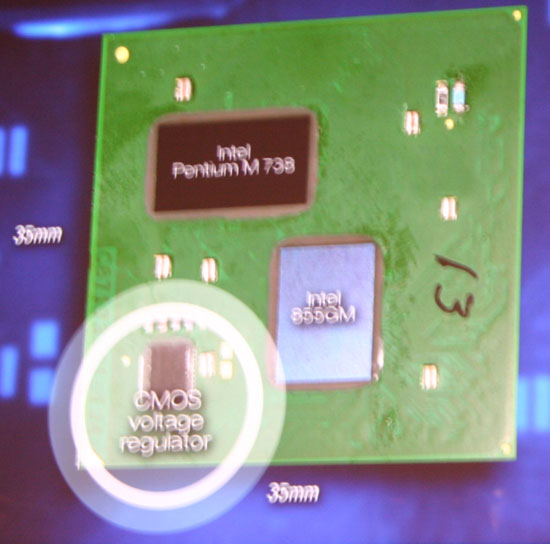
The benefits were two-fold: 1) Intel could manage fine grained voltage regulation with very fast transition times and 2) a tangible reduction in board component count.
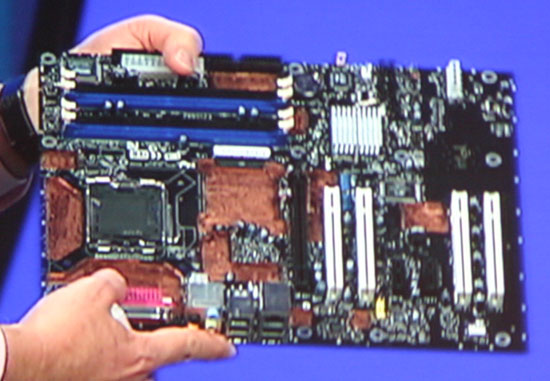
2005 - A prototype motherboard using the technology. Note the lack of voltage regulators on the motherboard and the missing GMCH (North Bridge) chip.
The second benefit is very easy to understand from a mobile perspective. Fewer components on a motherboard means smaller form factors and/or more room for other things (e.g. larger battery volume via a reduction in PCB size).
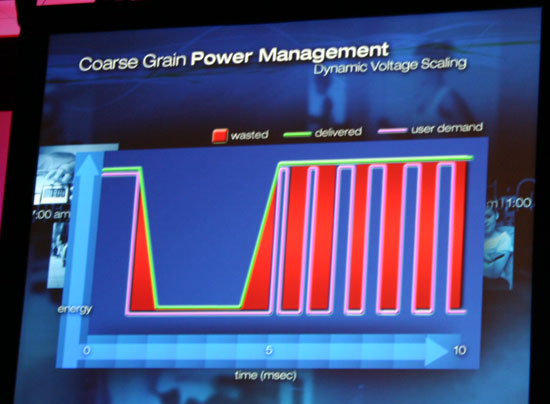

The first benefit made a lot of sense at the time when Intel introduced it, but it makes even more sense when you consider the most dramatic change to Haswell: support for S0ix active idle.


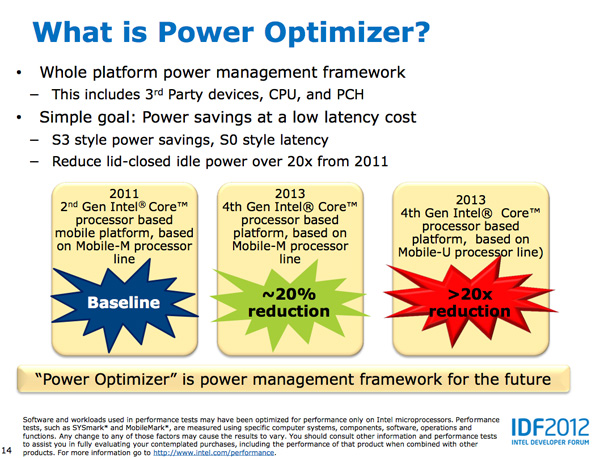
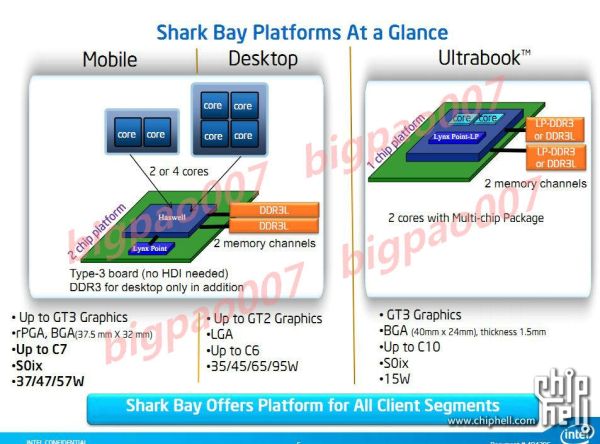








245 Comments
View All Comments
A5 - Friday, October 5, 2012 - link
8 years is a loooooong time in this space, and yes you (and most people here) are in the minority.Notebooks have been outselling desktops for several years, and in 2011 smartphone shipments were higher than all PC form-factors combined. It's pretty clear where the big bucks are going, and it isn't desktop PCs.
flamethrower - Friday, October 5, 2012 - link
In 8 years you'll have 50-inch OLED TVs on your walls. What's going to drive them? Possibly a computer integrated into them.Peanutsrevenge - Friday, October 5, 2012 - link
We'll just be using large screens, keyboards and mice wireless connected to our ultra portable devices.The desktop will likely still exist for people like us who frequent this site, however it's role will be far more specialised, possibly more as our personal cloud servers than our PCs.
yankeeDDL - Friday, October 5, 2012 - link
Wow. Thanks for the excellent article: I really enjoyed it.The thought of having a processor of the power level of Ivy bridge in my mobile phone blows my mind.
Honestly though, I really can't see how the volume of CPUs for desktop PCs and servers is going to drop so dramatically, that Intel will need the volume generated by mobile, to "survive".
Yes, of course more volume will help, but 8 years from now, even if the mobiles will have such kind of computational power, I would imagine that a Desktop would have 10~20x that performance, as it is today.
It's true that today's CPUs are typically more powerful than the average user ever needs, but raise the hand who wouldn't trade his CPU for one 10x faster (in the same power envelope) ...
That said, 10W still seems like a lot to fit in a mobile: who knows the power consumption of high-end mobile CPUs today? (quad-core Krait CPU, for example, or even Tegra3)
dagamer34 - Friday, October 5, 2012 - link
Intel's real problem is that the power needed for "good enough" computing in a typical desktop CPU came a couple of years ago Nd is rapidly approaching in mobile. With more and more tasks being offloaded to the cloud, battery life is becoming a stronger and stronger focus.What's sad is that because AMD isn't the major player it once was, Intel has allowed it's eye off the ball, revving Atom with only minor tweaks and having a laissez faire approach to GPU performance. It's only been recently when mobile has started to dominate in the minds of consumers and Intel's lack of any major design wins (the RAZR I doesn't count) which has forced Intel to push as hard as it is now.
sp3x0ps - Friday, October 5, 2012 - link
Where is the iPhone 5 review? I need details!! arghh.Demon-Xanth - Friday, October 5, 2012 - link
Atom was targeted to UMPCs, but quickly took over low power embedded systems who don't need much power but do run Windows.tipoo - Friday, October 5, 2012 - link
Poor Via.dgingeri - Friday, October 5, 2012 - link
"Within 8 years many expect all mainstream computing to move to smartphones, or whatever other ultra portable form factor computing device we're carrying around at that point."They said the same thing about laptops. Sure, laptops hold about 60-65% of the market these days, but the desktop is still very much around, and is the preferred platform for PC gamers and HTPC applications. They're far more flexible than any mobile form factor.
Smartphones also have the severe disadvantage of a very small screen. Even the largest are too small for most people to deal with. On top of that, actually surfing the net on those tiny screens is an exercise in frustration for many people. I try to tap on a link, only to get the link next to it, or above it, or below it, or possibly having my stupid phone just select the text instead of following the link.
Smartphones have their niche. There's no doubt there, but they are not going to be anyone's mainstream device unless they have needle thin fingers and 20/10 vision.
Anand Lal Shimpi - Friday, October 5, 2012 - link
I agree with the notebook/desktop comparison - these form factors won't go away. I should have said the majority of mainstream client computing goes to smartphones. And solving the display and input problems is easy: wireless display (WiDi/Miracast) and wireless keyboard/mouse (or a dock that does both over wires if you'd rather that).Take care,
Anand